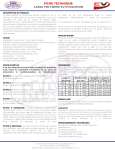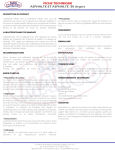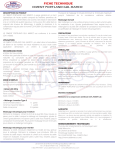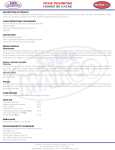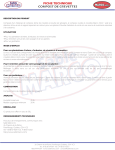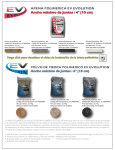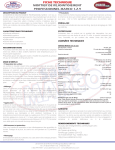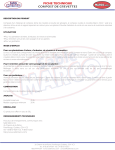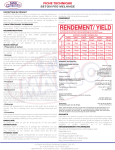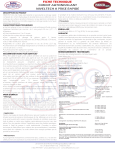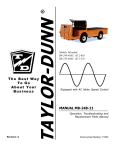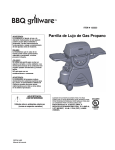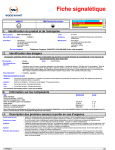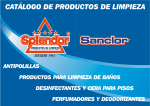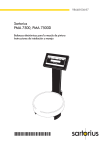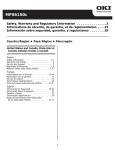Download fiche technique poussière de roche polymère ev
Transcript
FICHE TECHNIQUE POUSSIÈRE DE ROCHE POLYMÈRE EV EVOLUTION DESCRIPTION DU PRODUIT La poussière de roche polymère EV EVOLUTION formule ‘’Tout-en-un’’ est un mélange de pierre concassée tamisée et d‘un liant de polymère conçu pour l’installation de pavés et de pierres, tels les trottoirs, les entrées, patios, stationnements, etc. La poussière de roche polymère EV EVOLUTION permet de faire des travaux à l’horizontale ou en pente. Le remplissage des joints avec ce produit stabilise votre pavé tout en demeurant flexible aux mouvements. Il prévient la pousse de mauvais herbes et l’apparition de nids de fourmis dans les joints. Le produit s’applique à sec et durcit après arrosage. ÉTAPE 6 SÉCHAGE : Au moins 24 heures de séchage minimum sont nécessaires pour permettre à la poussière de roche de durcir et d’assurer une performance optimale. Plus le temps de durcissement est long, meilleure sera la qualité du produit ainsi que sa durée de vie. Une température froide et humide augmentera substantiellement le temps de durcissement. •La température minimale d’installation est de 0° Celsius (32° F). •Si de la pluie est attendue durant la période de séchage, nous recommandons de protéger le pavé avec une bâche ; enlever la bâche seulement quand la pluie est arrêtée. USAGE •Appliquer le produit à sec – Durcit après l’arrosage •Prévient la croissance de mauvaises herbes et des nids de fourmis •Peut-être utilisé à l’horizontale ou en pente •Résiste aux changements de températures •Disponible en trois couleurs : Noir, Gris et Beige •Largeur maximale des joints : 6” ( 15 cm) •Profondeur minimum de pénétration d’eau dans les joints : 1” (2,5 cm) •Prise rapide, facile à installer •Séchage rapide par temps beau et sec MISE EN GARDE •S’assurer de faire le travail par beau temps seulement. Attention, un orage ou une averse immédiatement après l’installation peut entrainer le déplacement de la poussière de roche polymère sur la surface du pavé. •Avant d’étendre la poussière de roche polymère s’assurer que vos blocs ou pierres soient complètement sèches pour que la poussière de roche ne s’y colle pas. S’assurer aussi que la surface soit exempte de poussière de roche polymère avant de l’arroser. •Avant d’appliquer un scellant, Il est recommandé d’attendre au moins 20 jours. Consulter le fournisseur de pavé afin de déterminer si MODE D’EMPLOI le pavé est prêt à recevoir le traitement. Il est très important d’avoir le fiche technique du produit en •Ce produit doit être remisé au sec. main avant de commencer l’installation et de suivre les instructions et recommandations du manufacturier. RENDEMENT Un sac de 22,7 kg (50 lb) de poussière de roche polymère ÉTAPE 1: Verser la poussière de roche polymère EV EVOLUTION EV EVOLUTION peut couvrir entre 1 et 4 mètres carrés (10 et 40 sur votre pavé complètement sec. pieds carrés) si les joints ont environ 1,3 à 5,1 cm (1/2’’ à 2’’) de longueur et que les pierres ont environ 5,1 cm (2’’) d’épaisseur. La ÉTAPE 2 : Étendre la poussière de roche polymère avec un balai quantité requise dépend de la forme des pierres ainsi que de la et s’assurer de remplir tous les joints complètement. largeur et de la profondeur des joints. ÉTAPE 3 : Frapper les pavés à l‘aide d’un maillet en caoutchouc afin EMBALLAGE d’améliorer le compactage du produit. Sacs de plastique de 22,7 kg ( 50 lb.). 63 sacs par palette. Les palettes sont recouvertes d’un emballage de plastique. ÉTAPE 4 : Afin d’assurer que rien ne colle à la surface du pavé, enlever toute poussière, sable ou résidus à l’aide d’un balai à poils fins GARANTIE Sable Marco inc. garantit ce produit s’il est utilisé conformément aux normes. et d’un souffleur à feuilles. ÉTAPE 5 ARROSAGE : Arroser partout et uniformément (300-500 pieds carrés) à la fois d’une pluie fine jusqu’au début d’accumulation d’eau pour éviter le déplacement de la poussière de roche. Il est important de vérifier si l’eau à pénétré au minimum 1’’ (2,5 cm). Pour vérifier, utilisez un tournevis et grattez afin de vous en assurer, ensuite re-compacter la poussière de roche. Éviter d‘inonder, car une trop grande quantité d’eau risquerait de prolonger le temps de prise. Les matériaux dont ce produit est composé sont de première qualité. Sable Marco inc. ne donne aucune garantie, qu’elle soit explicite ou implicite. En conséquence de cette garantie, nous (Sable Marco inc.) nous engageons à remplacer le produit défectueux ou à le rembourser. RENSEIGNEMENTS TECHNIQUES Pour plus de renseignements, communiquer avec : Sable Marco Inc. 26 Chemin de la Pêche Pont-Rouge Québec G3H 1C3 Tél. 418-873-4509 Fax. 418-873-2561 http://www.sablemarco.com/ 26 Chemin de la Pêche, Pont-Rouge (Québec), G3H 1C3 Tél : (418) 873-4509 - Fax : (418) 873-2561 1-866-999-4509 - www.sablemarco.com - [email protected] POLYMERIC STONE DUST EV EVOLUTION PRODUCT DESCRIPTION EV EVOLUTION polymeric stone dust is a specially formulated high performance mix of graded crushed stone and binding agent to fill pavers joints. EV EVOLUTION superior performance and durability is ideal for the installation of pavers and flagstones as well as replacing existing joints on sidewalks, patios, sloped driveways or walkways. EV EVOLUTION will remain stable and flexible and maintain its flexibility and durability in the most extreme weather conditions. USAGE •Apply product dry, hardens after spraying with water •Prevents weed growth and ant hills •Use horizontally or on sloped surfaces •Withstands hot and cold weather •Available in 3 colors : grey, black and beige •Maximum width of joints : 6” (15 cm) •Minimum wetting depth : 1” (2,5 cm) •Rapid setting and easy to install •Rapid setting in warm and sunny weather Y PO L TECHNICAL DATA SHEET ME RIC S TO NE D UST •Use this product at temperatures over 32° F (0° C). •In case of the possibility your project could be exposed to rainfall during the drying period, we recommand covering the area wih a tarp. REMINDER •Install the product only in good weather conditions. Rain showers immediatly after the installation could carry the polymeric stone dust back to the paver surface. Cover it up ! •Make sure the pavers, slabs or stones are dry before you start spreading the stone dust to avoid sticking or staining. Furthemore, make sure that pavers are free of polymeric stone dust before spraying with water. •Before using a sealer on you paved surface, we recommand to wait at least 20 days and check with the paver manufacturer to find out if it is safe to apply a sealer at this time. •This product must be stored in a dry place. INSTALLATION INSTRUCTIONS Follow the manufacturer’s instructions carefully. Have the technical data sheet on hand prior to the start of the installation (www.sablemarco.com) COVERAGE A 50 lbs (22,7 kg) bag of EV EVOLUTION polymeric stone dust can cover approximately between 10 and 40 square feet (1 and 4m ) if the joints are about 1/2’’ to 2’’ (1,3 to 5,1 cm) wide and the stones are STEP 1 : Pour the EV EVOLUTION polymeric stone dust on a about 2’’ (5,1 cm) thick. The quantity required depends on the shape completely dry surface. and size of the stonesas well as the width and thickness of the joints. STEP 2 : Using a push broom, spread the polymeric stone dust over PACKAGING the joints making sure to fill to the full depth of the paver, 22,7 kg (50 lb). per bag. 63 bags per pallet. stone or slab. WARRANTY STEP 3 : Hit the pavers with a rubber hammer in order to get bette The materials used in making this polymeric stone dust are of the compaction. highest quality under strict production control. Sable Marco has no control over the preparation and the application of the products, and STEP 4 : To avoid having the product sticking to the top of the therefore, cannot guarantee the end result. Sable Marco’s waranty is pavers, stones or slabs, remove all the remaining stone dust with a limited to the replacement or reimbursement of defective products. fine bristle brush and a leaf blower. Claims must be submitted to Sable Marco Inc., 30 days from the date the problem was discoveredwith a proof of purchase. STEP 5 WATTERING : Use a water hose with a spray nozzle to water the area with a gentle mist or shower setting, to avoid TECHNICAL INFORMATION displacing the polymeric stone dust. We recommand doing a spot For further information in the installation of this product, check to make sure the water has filtered through to a minimum of please contact : : 1’’ (2,54 cm) of the depth of the joint. Simply scratch the stone dust Sable Marco Inc. with a screwdriver or sharp object to visualize, then pack-it back to the 26 Chemin de la Pêche original condition. Do not over-water or flood, causing a runoff. Pont-Rouge Québec G3H 1C3 Tel. 418-873-4509 Fax. 418-873-2561 STEP 6 DRYING/SETTING : Allow at least 24 hours of drying time Toll free : 1-866-999-4509 for a maximum stability and performance of this product before http://www.sablemarco.com/ exposure to rain. Drying or hardening time will vary depending on weather conditions. Cold and damp temperatures will increase the drying time substantially 26 Chemin de la Pêche, Pont-Rouge (Québec), G3H 1C3 Tél : (418) 873-4509 - Fax : (418) 873-2561 1-866-999-4509 - www.sablemarco.com - [email protected] FICHA TÉCNICA POLVO DE PIEDRA POLIMÉRICO EV EVOLUTION DESCRIPCIÓN DEL PRODUCTO El polvo de piedra polimérico EV EVOLUTION fórmula "todo en uno" es una mezcla de piedra triturada tamizada y de un polímero aglutinante diseñado para la instalación de adoquines y piedras en aceras, calzadas, patios, estacionamientos, etc. El polvo de piedra polimérico EV EVOLUTION permite la realización de trabajos en superficies horizontales o inclinadas. El llenado de las juntas con este producto estabiliza los adoquines y al mismo tiempo les confiere flexibilidad al movimiento, ademas previene el crecimiento de malas hiervas y la aparición de nidos de hormigas. El producto se aplica en seco y endurece después del mojado. SECADO PASO : Un mínimo de 24 horas de secado es necesario para que el polvo de piedra polimérico endurezca y garantice un rendimiento óptimo. Entre mas tiempo tenga el producto para secar mejor será su calidad final y una vida útil mas larga tendra. Un tiempo frío y húmedo aumentará sustancialmente el tiempo de curado. USO • Aplicar en seco - Endurece después del mojado inicial • Previene el crecimiento de malas hierbas y nidos de hormigas • Se puede utilizar en superficies horizontales o inclinadas • Resistente a los cambios de temperatura • Disponible en tres colores: Negro, gris y beige • Ancho máximo de juntas: 6" (15 cm) • Profundidad mínima de penetración del agua en las juntas: 1 "(2,5 cm) • Rápido y fácil de instalar • Secado rápido en tiempo seco y soleado PRECAUCIÓN • Asegúrese de trabajar solamente cuando haga buen tiempo. Atención, una tormenta o una lluvia inmediatamente después de la instalación puede causar el desplazamiento del polvo de piedra polimérico sobre la superficie de los adoquines. • Antes de aplicar el producto asegúrese que los adoquines estén completamente secos para evitar que el polvo de piedra se adhiera a ellos. También asegúrese que la superficie esté libre del producto antes de mojarla. • Esperar por lo menos 20 días, antes de aplicar un sellante. Consulte al proveedor de los adoquines para determinar si estos ya están listo para recibir dicho tratamiento. • Este producto debe ser almacenado en un lugar seco. • La temperatura mínima de instalación es de 0° C (32° F). • Si se esperan lluvias durante el período de secado, se recomienda proteger la superficie con un plástico impermeable. Retire este protector cuando la lluvia se detenga. MODO DE EMPLEO Tener a la mano la ficha técnica del producto antes de iniciar la instalación y seguir las recomendaciones e instrucciones RENDIMIENTO del fabricante. Una bolsa de 22,7 kg (50 libras) de polvo de piedra polimérico EV EVOLUTION puede cubrir de 1 a 4 metros cuadrados (10 a 40 pies PASO 1: Verter el polvo de piedra estabilizador EV EVOLUTION cuadrados) cuando los adoquines tienen alrededor de 5,1 cm (2") de sobre adoquines completamente secos. espesor con juntas entre 1,3 y 5,1 cm (1/2" a 2") de longitud. La cantidad total requerida dependera de la forma de las piedras, asi PASO 2 : Dispersar el polvo de piedra polimérico con una escoba y come de lo ancho y la profundo de las juntas. asegúrese de llenar todas las juntas por completo. EMBALAJE PASO 3 : Golpear los adoquines con un martillo de goma para Bolsas en plástico de 22,7 kg (50 lb). 63 bolsas por paleta cubiertas mejorar la compactación del producto. con una envoltura plástica. PASO 4 : Para asegurarse de que nada se pegue a la superficie de GARANTÍA los adoquines, elimine todo residuo fino con la ayuda de una escoba Sable Marco inc. garantiza este producto si se utiliza de acuerdo con las normas. Los materiales que componen este producto son de primera y un soplador de hojas. PASO 5 RIEGO : Rocear por todas partes y de manera uniforme (300-500 pies cuadrados a la vez), con una lluvia fina (para evitar el movimiento del polvo de piedra) hasta el inicio de acumulación de agua en las juntas. Es importante asegurarse que el agua haya penetrado al menos 1" (2,5 cm), para comprobarlo utilice un destornillador y raspe la junta, a continuación, vuelva a compactar el producto. Evite inundar la instalación, ya que el exceso de agua puede prolongar el tiempo de fraguado. calidad. Sable Marco inc. no ofrece ninguna garantía, ya sea explícita o implícita. Como resultado de esta garantía, nosotros (Sable Marco inc.) nos comprometemos a sustituir el producto defectuoso o a reembolsarlo. INFORMACIÓN TÉCNICA Para obtener más información, comuníquese con: Sable Marco Inc. 26 Chemin de la Pêche Pont-Rouge Québec G3H 1C3 Tél. 418-873-4509 Fax. 418-873-2561 http://www.sablemarco.com/ 26 Chemin de la Pêche, Pont-Rouge (Québec), G3H 1C3 Tél : (418) 873-4509 - Fax : (418) 873-2561 1-866-999-4509 - www.sablemarco.com - [email protected] Fiche signalétique Stabiliz-O-Block EV SECTION 1 - IDENTIFICATION DU PRODUIT EV EVOLUTION Identificateur du produit/Nom commercial: 442; 444; 443; 445 Code du produit/Identification interne: Matériaux de construction. Sable polymère, Poussière de roche polymère. Usage du produit/Description: Silice Nom chimique : Silice Famille chimique: Le 30 avril 2012 Date de la fiche signalétique: Sable Marco,Inc. 26, Chemin de la Pêche, Pont-Rouge, QC, G3H 1C3, Tél. 418-873-4509 Identificateur du fournisseur: Même que le fournisseur Identificateur du fabricant: Numéro de téléphone d’urgence: Canutec 613-996-6666. Classification SIMDUT: D2A – Matière toxique ayant d’autres effets SECTION 2 - IDENTIFICATION DES DANGERS Vue d’ensemble en cas d’urgence ATTENTION Peut causer des irritations transitoires légères. *EFFETS POTENTIELS POUR LA SANTÉ* Contact cutané, absorption par la peau, contact oculaire, ingestion et inhalation. Voie d’administration Effets de l’exposition de courte durée (aiguë) : Peut causer des irritations transitoires légères. Inhalation: Peut causer des irritations transitoires légères. Peau: Peut causer des irritations transitoires légères. Yeux: Peut causer des irritations transitoires légères. Ingestion: Consulter la Section 11«Propriétés toxicologiques » pour plus de Effets de l’exposition à long terme (chronique) : renseignements. Autres dangers importants : Consulter la Section 11«Propriétés toxicologiques » pour plus de renseignements. SECTION 3 - COMPOSITION CHIMIQUE / INGRÉDIENTS DANGEREUX Ingrédients dangereux No. CAS % (poids) DL50 (voie, espèce) Silice cristalline, quartz 14808-60-7 60-100 P/D Copolymère d'éthylène et d'acétate de vinyle 24937-78-8 1-5 P/D CL50 (espèce) P/D P/D SECTION 4 - PREMIERS SOINS Inhalation: Retirer les sources de contamination ou déplacer la victime à l’air frais. Si la victime ne respire plus, administrer la respiration artificielle. Obtenir immédiatement des soins médicaux. Contact cutané: Rincer doucement la région affectée avec de l’eau courante. Obtenir des soins médicaux. Nettoyer les vêtements contaminés avant de les réutiliser. Contact oculaire: Rincer immédiatement les yeux affectés doucement avec de l’eau. Obtenir des soins médicaux. Ingestion: NE JAMAIS donner quoi que ce soit par la bouche si la victime perd rapidement conscience ou si elle est inconsciente ou en convulsion. Bien rincer la bouche avec de l’eau. NE PAS PROVOQUER LE VOMISSEMENT. Demander à la victime d’avaler deux verres d’eau. Si le vomissement se produit naturellement, faire pencher la victime vers l’avant afin de réduire les risques d’aspiration. Continuer de faire boire de l’eau. Obtenir immédiatement des soins médicaux. P/D – Pas disponible S/O – Sans objet Page 1 de 4 Fiche signalétique Stabiliz-O-Block EV SECTION 5 - PROCÉDÉS DE LUTTE CONTRE L’INCENDIE Risques d’incendie/conditions d’inflammabilité: Ne s’enflamme pas dans des conditions normales d’utilisation. > 200°C Point d’éclair (méthode) : P/D Limite d’inflammabilité inférieure (% par volume) : P/D Limite d’inflammabilité supérieure (% par volume) : Probablement insensible. Sensibilité aux chocs: Probablement insensible. Sensibilité aux décharges électrostatiques: P/D Température d’auto-inflammation: Dioxyde de carbone, agent chimique en poudre, et mousse adéquate pour les produits environnants. Moyens d’extinction: Procédés spéciaux de lutte contre l’incendie/équipement: De la fumée ou des émanations toxiques/irritantes peuvent se produire durant un incendie. Ne pas entrer dans le secteur de l’incendie sans avoir une protection adéquate. Les pompiers qui combattent un incendie devraient porter un appareil de protection respiratoire autonome avec un masque facial complet pour se protéger des produits toxiques libérés lors de la combustion. Protéger le personnel des contenants qui risquent d’éclater, d’exploser ou d’échapper leur contenu. Déplacer les contenants des lieux d’incendie s’il n’y a pas de danger. L’utilisation de l’eau peut être utile pour refroidir les contenants exposés à la chaleur et aux flammes. Oxydes de carbone et autres gaz et fumées irritants. Produits de combustion dangereux: SECTION 6 - MESURES EN CAS DE DÉVERSEMENT ACCIDENTEL Protection personnelle: Restreindre l’accès jusqu’à ce que le nettoyage soit terminé. Assurez-vous que le nettoyage est effectué par un personnel qualifié. Toutes les personnes mises en cause lors du nettoyage doivent porter un équipement de protection approprié (Voir Section 8). Intervention en cas de déversement/nettoyage: Ventiler les lieux du déversement. Arrêter l’écoulement si cela peut être fait en toute sécurité. Contenir et absorber avec une matière absorbante inerte. Ensuite, placer la matière absorbante dans un contenant pour élimination ultérieure (voir section 13). La matière absorbante contaminée peut présenter les mêmes dangers que le produit déversé. Aviser les autorités compétentes si nécessaire. Précautions environnementales: Éviter l’infiltration dans les égouts, dans les cours d’eau ou dans les espaces restreints. Disposer tout en respectant les règlements locaux, provinciaux et nationaux. SECTION 7 - MANUTENTION ET ENTREPOSAGE Procédures de manutention sécuritaire: Avant de manipuler ce produit, il est très important de s’assurer que les mesures d’ingénierie sont bien contrôlées et que les exigences relatives à la protection personnelle et à l’hygiène sont respectées. Les travailleurs qui utilisent ce produit chimique doivent avoir une formation en ce qui a trait aux risques associés à l’utilisation. Faire l’inspection des contenants pour y détecter les fuites avant la manutention. Étiqueter les contenants adéquatement. Assurez-vous de bien aérer. Éviter de respirer les poussières, les vapeurs ou les brouillards. Éviter tout contact avec les yeux, la peau et les vêtements. Éviter la production de concentrations élevées de poussières, vapeurs ou de brouillards. Tenir à l’écart des matières incompatibles comme les matières oxydantes fortes. Garder les contenants bien fermés lorsqu’ils ne sont pas utilisés. Les contenants vides sont toujours dangereux. Supposer que les contenants vides peuvent contenir des résidus dangereux. Exigences en matière d’entreposage: Entreposer dans un endroit frais, sec et bien ventilé. Entreposer à l’écart des matières incompatibles. Faites l’inspection de tous les contenants reçus afin de vous assurer qu’ils sont bien étiquetés et qu’ils ne sont pas endommagés. Le secteur d’entreposage doit être clairement identifié, libre d’obstacles et accessible seulement par le personnel qualifié. Périodiquement, faites une inspection afin de détecter des fuites. Matières incompatibles : MATIÈRES OXYDANTES FORTES. P/D – Pas disponible S/O – Sans objet Page 2 de 4 Fiche signalétique Stabiliz-O-Block EV SECTION 8 - CONTRÔLES DE L’EXPOSITION ET PROTECTION INDIVIDUELLE Limites d’exposition: Il n’existe aucune donnée pour ce produit. Voici les données pour chaque ingrédient : OSHA PEL ACGIH TLV Ingrédient TWA STEL TWA STEL Silice cristalline, quartz 10 mg/m3 P/D 0,025 mg/m3 P/D Copolymère d'éthylène et d'acétate de vinyle P/D P/D P/D P/D Mesures d’ingénierie: Utiliser le produit avec une bonne ventilation. Système de ventilation par aspiration à la source recommandé pour maintenir les concentrations de contaminants bien inférieures aux limites d’exposition. Protection des voies respiratoires: Protection respiratoire requise si les concentrations sont supérieures aux limites d’exposition. Utiliser un appareil respiratoire homologué NIOSH si les limites d’exposition sont inconnues. Vêtement et équipement de protection: Nous vous recommandons de porter des gants de protection contre les produits chimiques (imperméables), ou autres vêtements de protection pour empêcher un contact répété ou prolongé avec la peau durant toutes les opérations de manutention. Porter des lunettes à coques antiéclaboussures afin d’empêcher le produit d’entrer en contact avec les yeux. S’assurer que les douches oculaires, les douches de sécurité et les zones de nettoyage sont près du poste de travail. Commentaires sur l’hygiène général : Éviter la production de concentrations élevées de poussières, brouillards ou de vapeurs. Éviter tout contact avec la peau et les yeux. Éviter de respirer les poussières, vapeurs ou les brouillards. Ne jamais manger, boire ou fumer près des postes de travail. Une bonne hygiène est recommandée après l’utilisation de ce produit. Nettoyer les vêtements avant de les réutiliser. SECTION 9 - PROPRIÉTÉS PHYSIQUES ET CHIMIQUES Solide beige ayant une faible odeur. État physique, couleur et odeur: P/D Seuil de l’odeur: 6,5-8,5 P/D pH : Point d’ébullition: P/D P/D Point de fusion/congélation: Tension de vapeur: P/D P/D Coefficient de répartition huile/eau: Solubilité dans l’eau: P/D P/D Densité (eau = 1): Densité de vapeur (Air = 1): P/D P/D Taux d’évaporation (acétate de n-butyle = 1): % volatilité (volume): SECTION 10 - DONNÉES SUR LA RÉACTIVITÉ ET STABILITÉ Stable dans les conditions recommandées et prescrites de manutention et d’entreposage. Stabilité et réactivité : Aucune polymérisation dangereuse ne surviendra. Polymérisation: Conditions à éviter : Consulter les matières incompatibles à la Section 7. Consulter les matières incompatibles à la Section 7. Matières à éviter : Aucun connu. Consulter « Produits de combustion dangereux » dans la Section 5. Produits de décomposition dangereux : SECTION 11 - PROPRIÉTÉS TOXICOLOGIQUES Il n’existe aucune donnée pour le produit lui-même, seulement pour les ingrédients. Consulter la Données toxicologiques: Section 3 pour plus de renseignements. Silice cristalline, quartz est énumérée par IARC, ACGIH, NTP ou OSHA comme étant cancérigène. Cancérogénicité : P/D Tératogénicité, mutagénicité et autres effets sur la reproduction : P/D Sensibilisation de la peau : P/D Sensibilisation des voies respiratoires : P/D Conditions aggravées par l’exposition : P/D Matières synergiques : SECTION 12 - RENSEIGNEMENTS ÉCOLOGIQUES Il n’existe aucune donnée sur le produit lui-même. Impact sur l’environnement : P/D Caractéristiques environnementales importantes : P/D Toxicité pour les organismes aquatiques : P/D – Pas disponible S/O – Sans objet Page 3 de 4 Fiche signalétique Stabiliz-O-Block EV SECTION 13 - ÉLIMINATION DES DÉCHETS Conditions d’entreposage et de manutention : Entreposer les matières pour élimination tel qu’indiqué à la section 7 Manutention et entreposage. Passer en revue les exigences fédérales, provinciales et locales avant l’élimination. Méthodes d’élimination : SECTION 14 - RENSEIGNEMENTS RELATIFS AU TRANSPORT Renseignements sur le transport de marchandises dangereuses (TMD) : Description d’expédition: Non Réglementé Cas spécial: Aucun SECTION 15 - RENSEIGNEMENTS SUR LA RÉGLEMENTATION Renseignements SIMDUT: Le produit est réglementé selon le Règlement sur les Produits Contrôlés (RPC) au Canada. Consulter la Section 1 pour la classification SIMDUT. Ce produit a été classifié conformément aux critères de risques énumérés dans le Règlement sur les produits contrôlés (RPC) et cette fiche signalétique contient tous les renseignements exigés par le RPC. Renseignements Canadian Environmental Protection Act (CEPA): Les ingrédients sont inscrits sur la LIS. Renseignements OSHA États-Unis : Ce produit est réglementé selon OSHA. Cette fiche contient tous les renseignements requis par OSHA. Les ingrédients sont inscrits sur la TSCA. Renseignements TSCA États-Unis : National Fire Protection Association (NFPA): SANTÉ: 1 INFLAMMABILITÉ: 1 INSTABILITÉ: 0 AUTRES DANGERS: Voir Section 1 & 3. INDICES DE RISQUES: 0 Minimal 1 Léger 2 Modéré 3 Sérieux 4 Grave Ingredients to be disclosed on product labelling: Refer to Section 3. New Jersey Labeling Requirements: This product contains chemicals that are known to the State of California to cause cancer or California Proposition 65: other reproductive harm. SECTION 16 - AUTRES RENSEIGNEMENTS NSS ENTREPRISE INC. pour Sable Marco,Inc. Préparée par: Tél. 514-239-8785 ou 418-873-4509 Numéro de téléphone: Références: 1. Les fiches signalétiques du fabricant/fournisseur. 2. CSST, Répertoire Toxicologique, Les produits, 2012. 3. Canadian Centre for Occupational Health and Safety, CCInfoWeb databases, 2012. Abréviations: ACGIH American Conference of Governmental Industrial Hygienists AIHA American Industrial Hygiene Association CAS Chemical Abstract Service CL Concentration létale DL Dose létale IARC International Agency for Research on Cancer LIS Liste intérieure des substances (DSL) NIOSH National Institute for Occupational Safety and Health NTP National Toxicology Program (U.S.A.) OSHA Occupational Safety and Health Administration (U.S.A.) PEL Permissible Exposure Limit SIMDUT Système d’information sur les matières dangereuses utilisées au travail STEL Short-term Exposure Limit TLV Threshold Limit Value TSCA Toxic Substances Control Act TWA Time Weighted Average USEPA United States Environmental Protection Agency Avis au lecteur - Au meilleur de nos connaissances, l'information contenue dans ce document est exacte. Toutefois, ni le fournisseur ci-haut mentionné, ni aucune de ses succursales ne peut assumer quelque responsabilité que ce soit en ce qui a trait à l'exactitude ou à la complétude des renseignements contenus aux présentes. Il revient exclusivement à l'utilisateur de déterminer l'appropriation des matières. Toutes les matières peuvent présenter des dangers inconnus et doivent être utilisées avec prudence. Bien que certains dangers soient décrits aux présentes, nous ne pouvons garantir qu'il n'en existe pas d'autres. Fin de la fiche signalétique P/D – Pas disponible S/O – Sans objet Page 4 de 4 Material Safety Data Sheet: Stabiliz-O-Block EV SECTION 1 - PRODUCT IDENTIFICATION EV EVOLUTION Product identifier/Trade name: 442; 444; 445; 446 Product code/Internal Identification: Construction materials. Polymeric sand, polymeric stone dust. Product use/Description: Silica Product chemical name: Silica Chemical family: April 30, 2012 MSDS preparation/review date: Sable Marco,Inc. 26, Chemin de la Pêche, Pont-Rouge, QC, G3H 1C3, Tel. 418-873-4509 Supplier identifier: Same as supplier. Manufacturer identifier: Canutec 613-996-6666. Emergency phone number: D2A – Toxic material with other effects WHMIS Classification: SECTION 2 - HAZARDS IDENTIFICATION Emergency Overview CAUTION May cause slight transient irritations. *POTENTIAL HEALTH EFFECTS* Skin contact, skin absorption, eye contact, ingestion and inhalation. Primary entry route(s): Effects of short-term (acute) exposure: May cause slight transient irritations. Inhalation: May cause slight transient irritations. Skin: May cause slight transient irritations. Eye: Ingestion: May cause slight transient irritations. Effects of long-term (chronic) exposure: Refer to Section 11, Toxicological Information, for further information. Other important hazards: Refer to Section 11, Toxicological Information, for further information. SECTION 3 - CHEMICAL COMPOSITION / HAZARDOUS INGREDIENTS Hazardous Ingredients CAS # % (weight) LD50 (route, species) Silica-crystalline, Quartz 14808-60-7 60-100 N/Av Ethylene and vinyl acetate copolymer 24937-78-8 1-5 N/Av LC50 (species) N/Av N/Av SECTION 4 - FIRST AID MEASURES Inhalation: Remove source of contamination or have victim move to fresh air. If not breathing, give artificial respiration. Obtain medical attention immediately. Skin contact: Wash contaminated area with running water. Obtain medical attention. Launder contaminated clothing before re-use. Eye contact: Immediately flush the contaminated eye(s) with gently flowing water. Obtain medical attention. Ingestion: NEVER give anything by mouth if victim is rapidly losing consciousness, or is unconscious or convulsing. Rinse mouth thoroughly with water. DO NOT INDUCE VOMITING. Have victim drink two glasses of water. If vomiting occurs naturally, have victim lean forward to reduce risk of aspiration. Repeat administration of water. Obtain medical attention immediately. N/Av – Not available N/Ap – Not applicable Page 1 of 4 Material Safety Data Sheet: Stabiliz-O-Block EV SECTION 5 - FIRE FIGHTING MEASURES Does not burn under normal handling conditions. Fire hazards/conditions of flammability: Flash point (Method): > 200°C N/Av Lower flammable limit (% by volume): N/Av Upper flammable limit (% by volume): Probably not sensitive. Sensitivity to mechanical impact: Probably not sensitive. Sensitivity to static discharge: Auto-ignition temperature: N/Av Carbon dioxide, dry chemical powder and appropriate foam for surrounding products. Suitable extinguishing media: Special fire-fighting procedures/equipment: During a fire, irritating/toxic smoke and fumes may be generated. Do not enter fire area without proper protection. Firefighters should wear proper protective equipment and self-contained breathing apparatus with full facepiece. Shield personnel to protect from venting, rupturing or bursting cans. Move containers from fire area if it can be done without risk. Water spray may be useful in cooling equipment and cans exposed to heat and flame. Carbon oxides and other irritating fumes and smoke. Hazardous combustion products: SECTION 6 - ACCIDENTAL RELEASE MEASURES Personal precautions: Restrict access to area until completion of clean-up. Ensure clean-up is conducted by trained personnel only. All persons dealing with clean-up should wear the appropriate protective equipment (See Section 8). Spill response/Cleanup: Ventilate area of release. Stop the leak if it can be done safely. Contain and absorb any spilled liquid concentrate with inert absorbent material, then place material into a container for later disposal (see Section 13). Contaminated absorbent material may pose the same hazards as the spilled product. Notify the appropriate authorities as required. Environmental precautions: Confine spill, preventing it from entering sewer lines or waterways. Dispose of as per local, state and federal regulations. SECTION 7 - HANDLING AND STORAGE Safe handling procedures: Before handling, it is very important that engineering controls are operating, and that protective equipment requirements and personal hygiene measures are being followed. People working with this chemical should be properly trained regarding its hazards and its safe use. Inspect containers for leaks before handling. Label containers appropriately. Ensure proper ventilation. Avoid breathing dusts, vapours or mists. Avoid contact with eyes, skin and clothing. Avoid generating high concentrations of dusts, vapours or mists. Keep away from incompatible materials such as strong oxidizing materials. Keep containers closed when not in use. Empty containers are always dangerous. Assume that empty containers contain residues which are hazardous. Storage requirements: Store in a cool, dry and well-ventilated area. Store away from incompatible materials. Inspect all incoming containers to make sure they are properly labelled and not damaged. Storage area should be clearly identified, clear of obstruction and accessible only to trained personnel. Inspect periodically for damage or leaks. Incompatible materials: STRONG OXIDIZING MATERIALS. N/Av – Not available N/Ap – Not applicable Page 2 of 4 Material Safety Data Sheet: Stabiliz-O-Block EV SECTION 8 - EXPOSURE CONTROLS AND PERSONAL PROTECTION There is no available data for the product. See below for individual ingredient exposure limits. Exposure limits: OSHA PEL ACGIH TLV Ingredient TWA STEL TWA STEL Silica-crystalline, Quartz 10 mg/m3 N/Av 0.025 mg/m3 N/Av Ethylene and vinyl acetate copolymer N/Av N/Av N/Av N/Av Engineering controls: Use under well-ventilated conditions. Local exhaust ventilation system is recommended to maintain concentrations of contaminants below exposure limits. Respiratory Protection: Respiratory protection is required if the concentrations are higher than the exposure limits. Use a NIOSH approved respirators if the exposure limits are unknown. Protective Clothing/Equipment: We recommend wearing chemically protective gloves (impervious), and other protective clothing to prevent prolonged or repeated skin contact, during all handling operations. Wear protective chemical splash goggles to prevent product from entering the eyes. Make emergency eyewash stations, safety/quick-drench showers, and washing facilities available in work area. General Hygiene Considerations: Avoid generating high concentrations of dusts, vapours or mists. Avoid contact with skin and eyes. Avoid breathing dusts, vapours or mists. Never eat, drink, or smoke in work areas. Practice good personal hygiene after using this material. Remove and wash contaminated work clothing before re-use. SECTION 9 - PHYSICAL AND CHEMICAL PROPERTIES Slight odour; beige solid. Physical state, colour and odour: N/Av Odour threshold: 6.5-8.5 pH : N/Av Melting/freezing point: N/Av Coefficient of oil/water distribution: N/Av Specific gravity or density (water = 1): N/Av Evaporation rate (n-Butyl acetate = 1): Boiling point: Vapour pressure: Solubility in water: Vapour density (Air = 1): % volatile by volume: N/Av N/Av N/Av N/Av N/Av SECTION 10 - REACTIVITY AND STABILITY DATA Stable under the recommended storage and handling conditions prescribed. Stability and reactivity: Hazardous polymerization will not occur. Polymerization: Incompatible materials (see Section 7). Conditions to avoid: Incompatible materials (see Section 7). Materials to avoid: None known. Refer to ‘Hazardous combustion products’, Section 5. Hazardous decomposition products: SECTION 11 - TOXICOLOGICAL INFORMATION Toxicological data: There is no available data for the product itself, only for the ingredients. For more details, refer to Section 3. Silica-crystalline, Quartz is listed by IARC, ACGIH, NTP or OSHA as a carcinogen. Carcinogenicity: N/Av Teratogenicity, mutagenicity, other reproductive effects: N/Av Skin sensitization: N/Av Respiratory tract sensitization: N/Av Conditions aggravated by exposure: N/Av Synergistic materials: SECTION 12 - ECOLOGICAL INFORMATION There is no available data on the product itself. Environmental effects: N/Av Important environmental characteristics: N/Av Aquatic toxicity: N/Av – Not available N/Ap – Not applicable Page 3 of 4 Material Safety Data Sheet: Stabiliz-O-Block EV SECTION 13 - WASTE DISPOSAL Store material for disposal as indicated in Handling and Storage (Section 7). Handling and storage conditions for disposal: Review federal, provincial and local government requirements prior to disposal. Methods of disposal: SECTION 14 - TRANSPORTATION INFORMATION Transportation of Dangerous Goods Regulations (TDGR) : Shipping description: Not Regulated Special case: None SECTION 15 - REGULATORY INFORMATION WHMIS information: Product is regulated according to the Controlled Product Regulations (CPR) in Canada. Refer to Section 1 for the appropriate WHMIS classification. This product has been classified in accordance with the hazard criteria of the Controlled Products Regulations (CPR) and this MSDS contains all the information required by the CPR. The ingredients in this product are listed on the DSL. Canadian Environmental Protection Act (CEPA) information: United States OSHA information: This product is regulated according to OSHA. This MSDS contains all the information required by OSHA. The ingredients in this product are listed on the TSCA. United States TSCA information: National Fire Protection Association (NFPA): HEALTH: 1 FLAMMABILITY: 1 INSTABILITY: 0 SPECIAL HAZARDS: Refer to Section 1 & 3. HAZARD SCALE: 0 = Minimal 1 = Slight 2 = Moderate 3 = Serious 4 = Severe Ingredients to be disclosed on product labelling: Refer to Section 3. New Jersey Labeling Requirements: This product contains chemicals that are known to the State of California to cause cancer or other California Proposition 65: reproductive harm. SECTION 16 - OTHER INFORMATION NSS ENTREPRISE INC. for Sable Marco,Inc. Prepared by: Tel. 514-239-8785 or 418-873-4509 Telephone number: References: 1. Material Safety Data Sheets from manufacturer/supplier. 2. CSST, Répertoire Toxicologique, Les produits, 2012. 3. Canadian Centre for Occupational Health and Safety, CCInfoWeb databases, 2012. Abbreviations: ACGIH American Conference of Governmental Industrial Hygienists AIHA American Industrial Hygiene Association CAS Chemical Abstract Service DSL Domestic Substance List IARC International Agency for Research on Cancer LC Lethal concentration LD Lethal Dosage N/Ap Not applicable N/Av Not available NIOSH National Institute for Occupational Safety and Health NTP National Toxicology Program (U.S.A.) OSHA Occupational Safety and Health Administration (U.S.A.) PEL Permissible Exposure Limit STEL Short-term Exposure Limit TLV Threshold Limit Value TSCA Toxic Substances Control Act TWA Time Weighted Average WHMIS Workplace Hazardous Materials Information System Notice to reader - To the best of our knowledge, the information contained herein is accurate. However, neither the above named supplier nor any of its subsidiaries assumes any liability whatsoever for the accuracy or completeness of the information contained herein. Final determination of suitability of any material is the sole responsibility of the user. All materials may present unknown hazards and should be used with caution. Although certain hazards are described herein, we cannot guarantee that these are the only hazards that exist. End of the MSDS N/Av – Not available N/Ap – Not applicable Page 4 of 4











